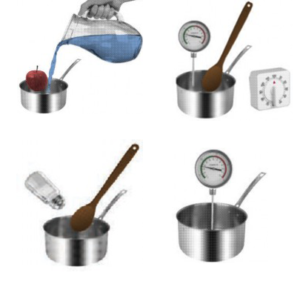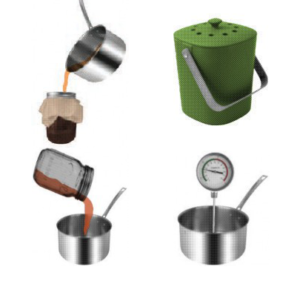Tannins are contained in plant polyphenols which can be found in many species of plants. Tannins are astringent, and cause the mouth to pucker if they are eaten – the best example of this is eating an unripened fruit. The reason they are used in tanning is that they bind to proteins, locking them in place, which causes them to stiffen.
Tannins are often extracted from wood, bark, nuts, and leaves due to their higher concentration,
however, tannins are also found in common beverages such as coffee, wine, tea, fruit juice, and in common foods like chocolate, fruits, legumes, and grains. Tannins are used in the process of tanning leather.
The contents of this zine are derived from a workshop delivered during Fibreshed Field School, by Dr. Love-Ese Chile, the Founder and Technical Director of circular waste research and testing company Regenerative Waste Labs. While this zine uses apple pomace as an example, it can be substituted by other plants or foods.
Tannin Extraction Experiment
What You’ll Need
- Large Saucepan
- Wooden Spoon
- Kitchen Scale
- Kitchen thermometer
- 1 L Beaker
- Access to refrigerator
- 3-5 cheese cloths (washcloth sized)
- 16 oz. mason jar and lid
- 50 G of salt
- 150 G of dry apple pomace, or 1 L of wet apple pomace

Step 1: Simmering
- Mix 150 g of dry apple pomace with 1 L of water in a large saucepan or add whole 1 L of wet pomace to large saucepan
- Bring to boil then reduce heat and simmer at 70 °C for at least 2 hours. Stir regularly.
- Add 25 g of salt and stir Salt is added to stop the degradation.
- Let cool down to room temperature (20 °C). You can store it in the refrigerator until you are ready for the next step.

Step 2: Separating Liquid
- Use a cheese-cloth to separate the solids from the liquids. Collect as much liquid as possible in a Mason jar.
- Discard the remaining slurry into an organic waste bin.
- Take the separated liquid and simmer at 70 °C until the volume is reduced to approximately 100 ml.
- Let the liquid cool down to 20 °C before storing it in the refrigerator. Make sure to label the contain-er with the date and “Dry Apple Pomace”
Tannin Strength Experiment
What You’ll Need
- 5 G salt
- 2 G gelatin
- 1 L of water Measuring cup (liq)
- Medium saucepan
- 4 X 8 oz. Mason jars with lids
- 2 Funnels
- 6 Cone shaped coffee filters
- Hairdryer or Oven Kitchen scale Commercial tannin extracts solution
Step 1: Prepare Gelatin Solution
- Dissolve 5 g of salt in 250 ml (1 cup) of warm water (~60 ˚C)
- Add 2 g of gelatin to the salt solution and stir until it dissolves.
- Keep mixture above 30 ˚C to make sure it does not set.
Step 2: Measure Out the Tannins
- Put 20 ml (1 oz) of each apple pomace extract into an 8 oz Mason jar.
- Put 20 ml of the commercial tannin solution into an 8 oz Mason jar.
Step 3: Add Gelatin
- To each jar add 50 ml (2 oz) of the gelatin solution.
- Put on the Mason jar lids and swirl the solutions.
- Allow any solids to settle.
Step 4: Filter the Solids
- Set up a filtration system by placing a funnel into an empty 8 oz. Mason jar and inserting a cone-shaped coffee filter into the funnel.
- Pour the gelatin mixtures into the filter paper and allow the liquid to separate from the solids.
- After all the solids have been collected, dry them with a hairdryer or in the oven for 1 hour at 80 °C.
Step 5: Measure the Mass
- Once dry, measure the mass of solids obtained from the apple pomace extracts and the commercial tannin.
- Compare the mass of the gelatin from the apple pomace extract with that of the commercial tannin.